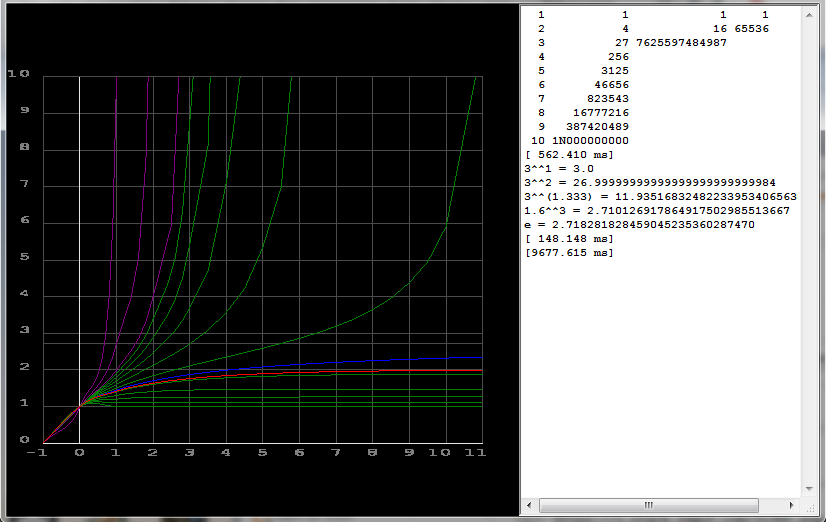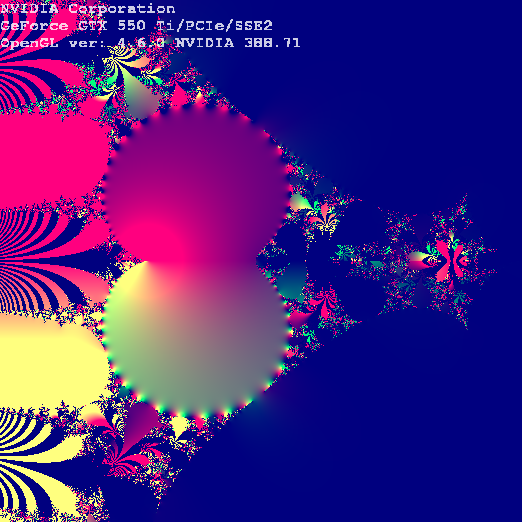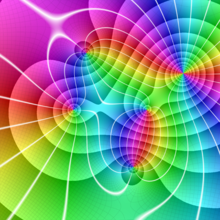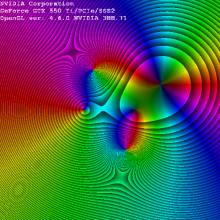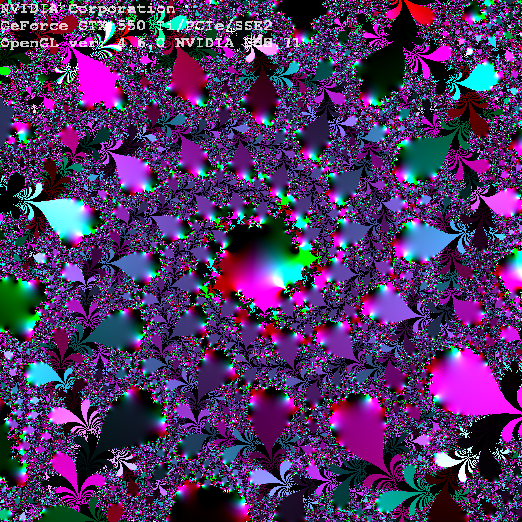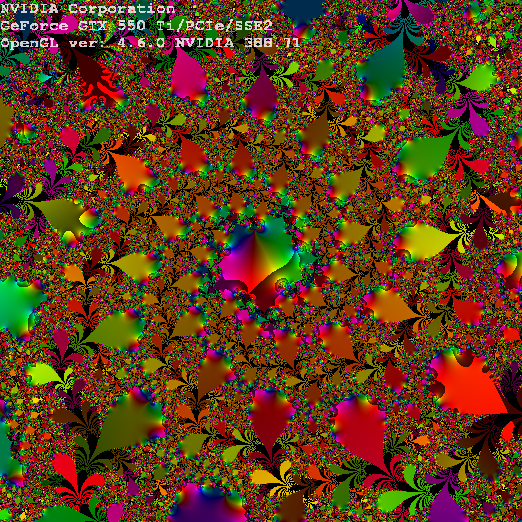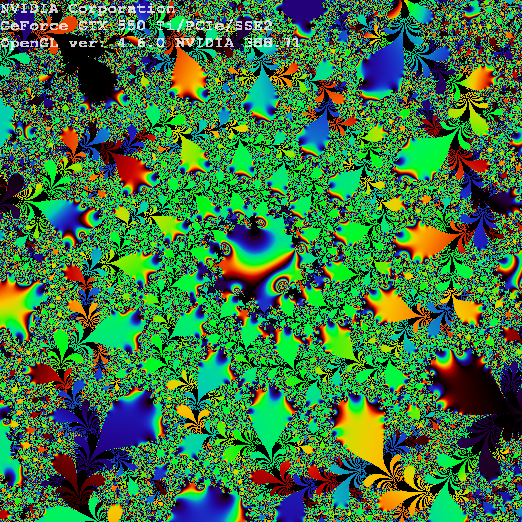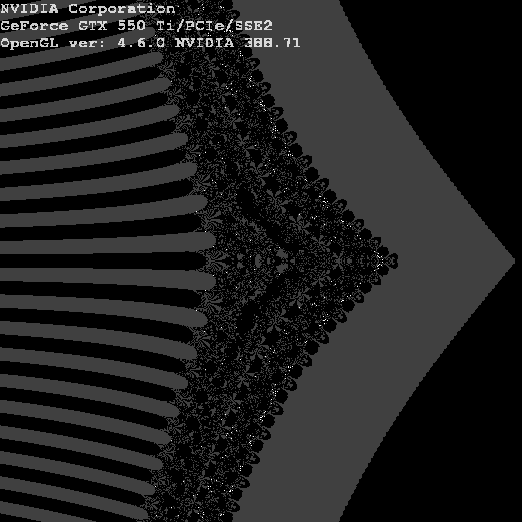well lets start with Real domain and integer b only:
a^^b = a^a^a^a^a...^a // a is there b times
this can be evaluated like this in C++:
double tetration(double a,int b) // a^^b = a^a^a^a... b times
{
double c;
if (b<=0) return 0;
for (c=a;b>1;b--) c=pow(a,c);
return c;
}
as You already got the pow for complex domain you can do the same there too... To keep this simple I will not touch that for now ...
Here some results:
a\b| 1| 2| 3| 4
-------------------------------
1 | 1| 1| 1| 1
2 | 2| 4| 16|65536
3 | 3| 27|7625597484987|
4 | 4| 256| |
5 | 5|3125| |
btw. all of these hyper operations are related to Ackermann function you can find iterative implementation of mine in C++ in here:
However due to extremly fast growth even double will out of range soon (hence missing values)...
Now how to move the b to Real domain? Have not a clue about algebraic approach for this but geometric one is possible.
Simply "plot" a^^b as a function of variable b and constant a for integer values of b around your wanted real b and then interpolate Real domain b using Integer domain b as control points. Its similar to obtaining non integer order derivation of a function.
So (X,Y) will be your (a^^b,b). Now use any interpolation to construct Real domain function.
Linear interpolation will look like this:
y0 = a^^(int(b))
y1 = a^^(int(b)+1)
a^^b = y0 + (b-int(b))*(y1-y0)
However higher order interpolation is needed and also the interpolation parameter should be scaled to non linear metrics. For more info see:
After some elaboration cubics (t^3) and log^2 scale proved to be sufficient (C++ example using my 128 bit floating point f128 class just rename it to double):
f128 tetration_fi(f128 a,int b) // a^^b = a^a^a^a... b times
{
f128 c;
if (b==-1) return 0.0; // first singularity
if (b== 0) return 1.0; // second singularity
if (b< -1) return 0.0; // uncomputed
for (c=a;b>1;b--) c=pow(a,c);
return c;
}
//---------------------------------------------------------------------------
f128 tetration_ff(f128 a,f128 b) // a^^b = a^a^a^a... b times
{
int bi;
f128 z0,z1,z2,z3,a0,a1,a2,a3,t,tt,ttt,o=2.0;
if (b==-1) return 0.0; // first singularity
if (b== 0) return 1.0; // second singularity
if (b< -1) return 0.0; // uncomputed
bi=b.ToInt(); b-=bi;
if (b.iszero()) return tetration_fi(a,bi);
z0=tetration_fi(a,bi-1); // known points around a^^b
z1=pow(a,z0);
z2=pow(a,z1);
z3=pow(a,z2);
z0=log2(log2(z0+o)+o); // log^2 scale
z1=log2(log2(z1+o)+o);
z2=log2(log2(z2+o)+o);
z3=log2(log2(z2+o)+o);
t =0.5*(z2-z0); // cubic interpolation coeff.
tt=0.5*(z3-z1);
a0=z1;
a1=t;
a2=(3.0*(z2-z1))-(2.0*t)-tt;
a3=t+tt+(2.0*(z1-z2));
t=b-bi; // cubic interpolation
tt=t*t;
ttt=tt*t;
z0=a0+(a1*t)+(a2*t*t)+(a3*t*t*t);
z0=exp2(exp2(z0)-o)-o; // linear scale
return z0;
}
//---------------------------------------------------------------------------
![final real preview]()
This is what I compared it with:
I select the same graph bases a from a^^b and as you can see its a very good match only range below 1.0 is slightly off.
Lets go for the Complex domain fractal
Now when you want to go to complex domain you can not do the same as in Real because the results are too chaotic for interpolation. So we can only stick to integer b or use the Kneser algorithm to compute.
Luckily for us there are more ways on show the fractal... For example we can evaluate integer b from the a^^b where only the a is complex and use the result for coloring the output. Here GLSL example (based on mine Mandelbrot shader and your complex math):
Fragment:
// Fragment
#version 450 core
uniform dvec2 p0=dvec2(0.0,0.0); // mouse position <-1,+1>
uniform double zoom=1.000; // zoom [-]
in smooth vec2 p32;
out vec4 col;
//---------------------------------------------------------------------------
// All components are in the range [0…1], including hue.
vec3 rgb2hsv(vec3 c)
{
vec4 K = vec4(0.0, -1.0 / 3.0, 2.0 / 3.0, -1.0);
vec4 p = mix(vec4(c.bg, K.wz), vec4(c.gb, K.xy), step(c.b, c.g));
vec4 q = mix(vec4(p.xyw, c.r), vec4(c.r, p.yzx), step(p.x, c.r));
float d = q.x - min(q.w, q.y);
float e = 1.0e-10;
return vec3(abs(q.z + (q.w - q.y) / (6.0 * d + e)), d / (q.x + e), q.x);
}
//---------------------------------------------------------------------------
// All components are in the range [0…1], including hue.
vec3 hsv2rgb(vec3 c)
{
vec4 K = vec4(1.0, 2.0 / 3.0, 1.0 / 3.0, 3.0);
vec3 p = abs(fract(c.xxx + K.xyz) * 6.0 - K.www);
return c.z * mix(K.xxx, clamp(p - K.xxx, 0.0, 1.0), c.y);
}
//---------------------------------------------------------------------------
vec3 spectral_color(float l) // RGB <0,1> <- lambda l <400,700> [nm]
{
float t; vec3 c=vec3(0.0,0.0,0.0);
if ((l>=400.0)&&(l<410.0)) { t=(l-400.0)/(410.0-400.0); c.r= +(0.33*t)-(0.20*t*t); }
else if ((l>=410.0)&&(l<475.0)) { t=(l-410.0)/(475.0-410.0); c.r=0.14 -(0.13*t*t); }
else if ((l>=545.0)&&(l<595.0)) { t=(l-545.0)/(595.0-545.0); c.r= +(1.98*t)-( t*t); }
else if ((l>=595.0)&&(l<650.0)) { t=(l-595.0)/(650.0-595.0); c.r=0.98+(0.06*t)-(0.40*t*t); }
else if ((l>=650.0)&&(l<700.0)) { t=(l-650.0)/(700.0-650.0); c.r=0.65-(0.84*t)+(0.20*t*t); }
if ((l>=415.0)&&(l<475.0)) { t=(l-415.0)/(475.0-415.0); c.g= +(0.80*t*t); }
else if ((l>=475.0)&&(l<590.0)) { t=(l-475.0)/(590.0-475.0); c.g=0.8 +(0.76*t)-(0.80*t*t); }
else if ((l>=585.0)&&(l<639.0)) { t=(l-585.0)/(639.0-585.0); c.g=0.84-(0.84*t) ; }
if ((l>=400.0)&&(l<475.0)) { t=(l-400.0)/(475.0-400.0); c.b= +(2.20*t)-(1.50*t*t); }
else if ((l>=475.0)&&(l<560.0)) { t=(l-475.0)/(560.0-475.0); c.b=0.7 -( t)+(0.30*t*t); }
return c;
}
//---------------------------------------------------------------------------
// complex domain math
vec3 color_wheel(vec2 a) // complex -> polar -> HSV -> RGB
{
float an=(atan(-a.y,-a.x)*0.15915494309189533576888376337251)+0.5;
float r=length(a); r-=floor(r); r*=0.75; r+=0.25;
return hsv2rgb(vec3(an,1.0,r));
}
vec3 color_spectral(vec2 a) // complex -> wavelength -> RGB
{
float r=length(a); r-=floor(r);
return spectral_color(400.0+(300.0*r));
}
vec2 cadd(vec2 a,vec2 b) // a+b
{
return a+b;
}
vec2 csub(vec2 a,vec2 b) // a-b
{
return a-b;
}
vec2 cmul(vec2 a,vec2 b) // a*b
{
return vec2((a.x*b.x)-(a.y*b.y),(a.x*b.y)+(a.y*b.x));
}
vec2 cdiv(vec2 a,vec2 b) // a/b
{
float an=atan(-a.y,-a.x)-atan(-b.y,-b.x);
float r=length(a)/length(b);
return r*vec2(cos(an),sin(an));
}
vec2 csqr(vec2 a) // a^2
{
return cmul(a,a);
}
vec2 cexp(vec2 a) // e^a
{
// e^(x+y*i)= e^x * e^(y*i) = e^x * ( cos(y) + i*sin(y) )
return exp(a.x)*vec2(cos(a.y),sin(a.y));
}
vec2 cln(vec2 a) // ln(a)
{
return vec2(log(length(a)),atan(a.y,a.x));
}
vec2 cpow(vec2 a,vec2 b) // a^b
{
return cexp(cmul(cln(a),b));
}
vec2 ctet(vec2 a,int b) // a^^b
{
vec2 c=vec2(1.0,0.0);
for (;b>0;b--) c=cpow(a,c);
return c;
}
//---------------------------------------------------------------------------
void main()
{
// poistion (double)
dvec2 p=dvec2(p32);
p=(p/zoom)-p0; // x,y (-1.0, 1.0)
// position (float)
vec2 pp=vec2(p);
// [chose function]
// complex domain test function 1 (color wheel)
// vec2 a=cdiv(cmul(csub(cmul(pp,pp),vec2(1.0,0.0)),csqr(csub(pp,vec2(2.0,1.0)))),cadd(csqr(pp),vec2(2.0,2.0)));
// complex domain test function 2 (color wheel)
// vec2 a=pp; a=cln(a);
// exponentiation escape fractal 1 (color wheel)
// vec2 a=cpow(pp,vec2(100,0));
// exponentiation escape fractal 2 (color wheel)
// vec2 a=vec2(1.0,1.0); for (int i=0;i<100;i++) a=cpow(a,pp);
// exponentiation escape fractal 3 (color wheel)
// vec2 a=vec2(0.0,0.0),b=vec2(1.0,0.0); float r=0.5,rr=1.0,wt=0.1; for (int i=0;i<20;i++){ a+=rr*cexp(vec2(-b.y,b.x)*wt); b=cmul(b,pp); rr*=r; } a*=(1.0-r);
// tetration escape fractal (grayscale)
// vec2 a=ctet(pp,100);
// pentation escape fractal (grayscale)
vec2 a=pp; for (int i=0;i<20;i++) a=ctet(a,20); a*=100.0;
// [chose coloring method]
// grayscale based on escape
float r=0.2*length(a); r-=floor(r); r=0.25+0.75*r; col=vec4(r,r,r,1.0);
// RGB based on result
// col=vec4(a,a.x+a.y,1.0);
// result -> wavelength+intensity
// col=vec4(color_wheel(a),1.0);
// result -> spectral color
// col=vec4(color_spectral(a),1.0);
}
And tetration preview:
![complex preview]()
This is what I compared with:
and it matches my result is just mirrored in both x,y
So what I did was computing a^^100 where a is complex domain position of fragment on screen <-1,+1> with some panning and zooming and render the color constructed from the result ...
I leave there also a test function (not fractal) I used to test the coloring methods and complex math taken from here the first is from Wiki the second is shader result (color wheel):
![test function Wiki]()
![test function mine]()
You can do escape testing like for mandelbrot or whatever else algo to show the fractal instead.
Here coloring options screenshots of tetration (I like the grayscale) of zoom=500.0 pos=-0.188418+0.234466i
![enter image description here]()
![enter image description here]()
![enter image description here]()
![enter image description here]()
And finally pentation:
![enter image description here]()
![enter image description here]()

